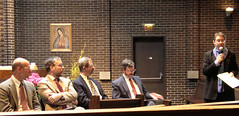Interpreting the Bible in a Sea of Signs
Late draft for an article published in the Yale Divinity School alumni/ae magazine Reflections, Spring 2008, pages 53-57. I reckon this draft differs from the final copy in some respects, but the differences should be slight.
I came to Yale as a refugee from the early days of the computer graphics industry. Business had been good, and would eventually get much better, but as soon as I set foot on campus and heard the clatter of late-summer typewriters settling the academic debts of spring semester, Yale drew me into the musty delights of the Higher Criticism, three different library classification systems, and Coffee Hour.
Once I settled into my seminary studies, however, I discovered that my fascination with biblical studies engendered a baffling problem: the more I learned in my biblical courses, the less my studies seemed to enhance my ministry and preaching. Like any good academic apprentice, I tried at first to redouble my efforts. That only aggravated the problem; I knew more and more, but the technical apparatus of my learning always seemed to stand between me and the fluent, compelling, preach-able biblical theology for which I thirsted. My increasing technical expertise did not help me inhabit and proclaim the traditions I was studying.
My teachers at Yale Divinity encouraged me to keep chipping away at this complex of problems: in biblical theology with Brevard Childs, literary theory with Richard Hays, postmodernism with Cornel West, among others. Gradually, the puzzle pieces came together. Their inspiration and instruction helped me articulate a way of understanding interpretation that produced theologically rich readings of scripture, but also allowed for a nuanced, historical-critical approach to the Bible.
My way forward involved learning to explore the Bible and Christian tradition without participating in the ceaseless power struggle over whose interpretation is authoritatively right and whose is wrong. This means sidestepping — recuperating from — a fixation on the illusory authority of claiming the “correct” interpretation. I offer instead a way of thinking about interpretation that still involves deliberation about better and sounder interpretations, but without pretensions to decisive interpretive authority. This proposal is unlikely to assuage our fiery passion to claim privileged possession of biblical correctness. But it may afford the incalculable advantage of clarifying the bases of our interpretations, and the bases of the relation of our interpretations to our dogmatic conclusions, our ecclesiology and our ethics.
Continue reading “Interpreting the Bible in a Sea of Signs”
